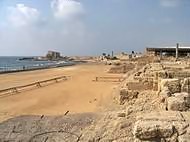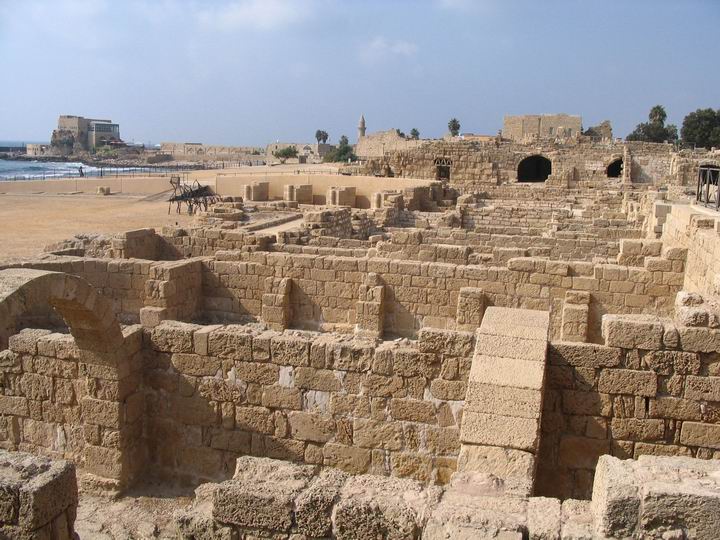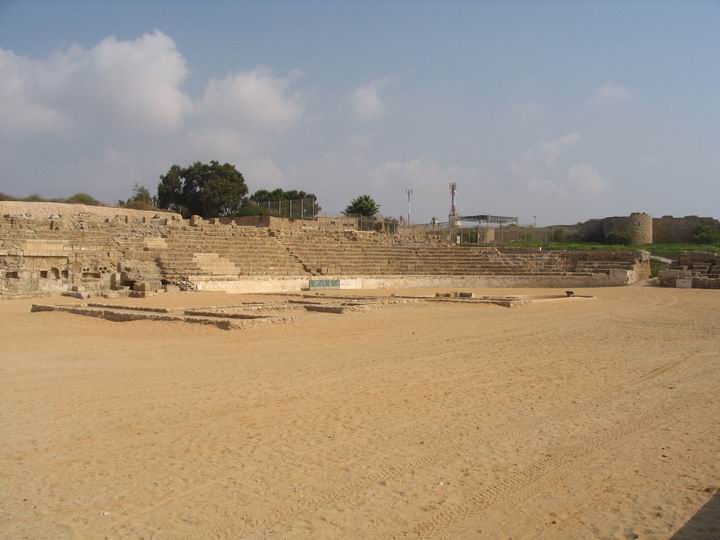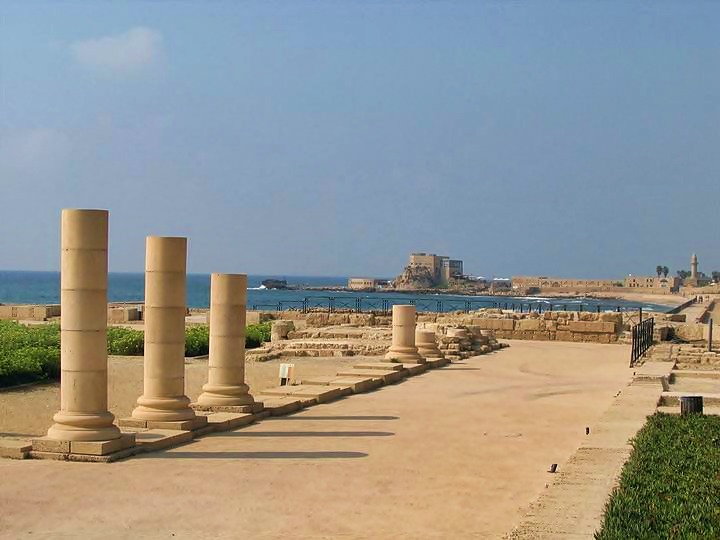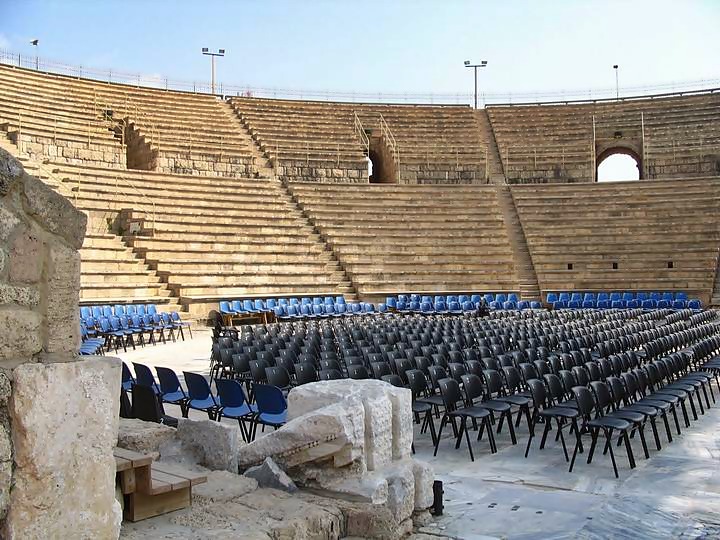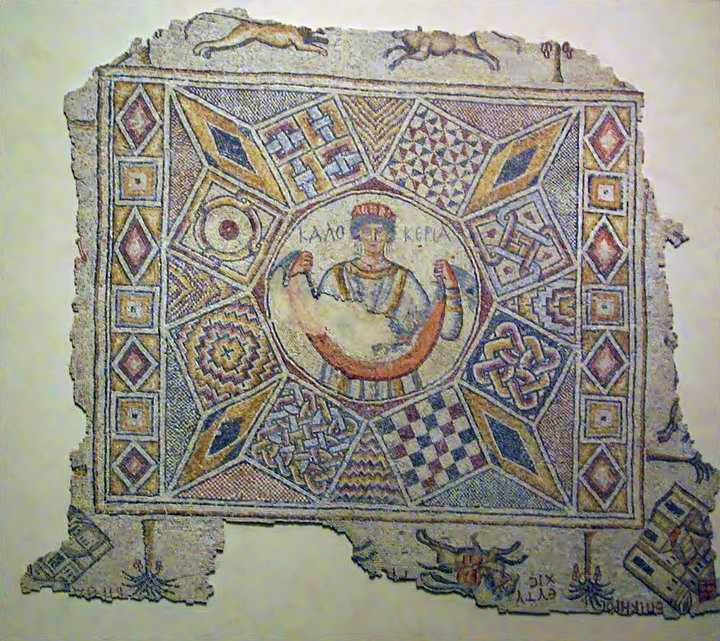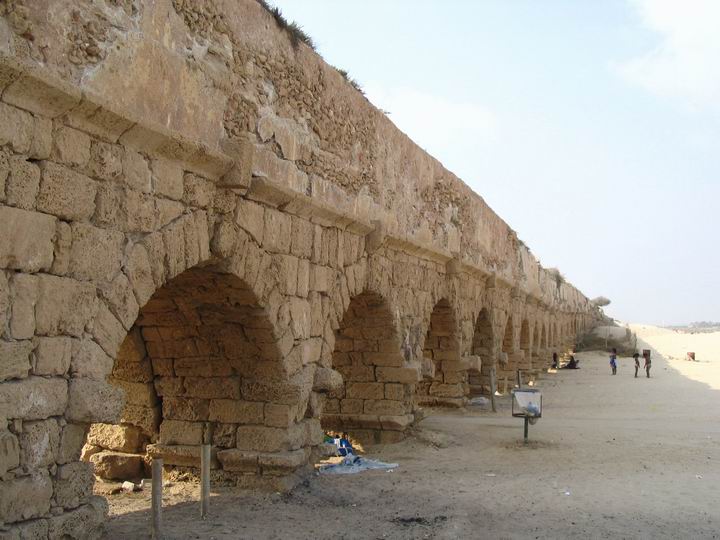Caesarea Maritima (“by the Sea”) is one of the most important cities in the Roman World, and a Crusader fortress along the road from Acre to Jerusalem.
Home > Sites > Sharon > Caesarea Maritima (overview)
Contents:
Background
History
Photos
* Crusaders Fortress
* Roman city
* Aqueduct
Biblical
Aerial Video
Links
Background:
Caesarea Maritima (“by the Sea”) is an ancient port city located on the Mediterranean coast of Israel, about halfway between Tel Aviv and Haifa. The city was founded by Herod the Great in the 1st century BC and was named after the Roman Emperor Caesar Augustus. During the Roman and Byzantine periods, Caesarea was an important center of trade and commerce. It was also the capital of the Roman province of Judea, and the site of numerous historical events, including the trial of the apostle Paul and the conversion of the Roman governor Cornelius to Christianity.
Today, Caesarea is an archaeological site that contains many impressive ruins and artifacts from its ancient past. Visitors can explore the remains of Herod’s palace, the Roman theater, the hippodrome, the aqueduct, the Crusader city, and the harbor. There is also a museum on site that displays many of the artifacts that have been discovered during the excavations.
In addition to its historical and archaeological significance, Caesarea is also a popular tourist destination because of its beautiful beaches and modern marina, which offer a variety of water sports and recreational activities.
History of the place:
Initially, Caesarea was a Phoenician site in the Persian period (6 to 3rd century BC). The Phoenicians, maritime merchants of the ancient world, used the natural bays and the nearby rivers in order to establish a port, one of many ports that they set up along the shore stretching from Tyre down to Gaza. The city flourished at the Greek period. Later, in the Roman period, King Herod created it into one of the largest cities in the Roman World, and called it after his patron, Augustus Caesar. The site was an important Roman city, and played an important role in the history of Ancient Israel. The city later decayed after the Arab conquest (8th century AD).
Caesarea returned to glory with the Crusaders (13th century). After their retreat the city was left in ruins, and its stones were reused in buildings throughout the region.
Photos:
(a) Crusaders fortress:
An aerial view, captured by a drone 80m above the southeast side, shows an overview of the ruined Crusaders fortress. Notice the moat along the exterior sides of the walls, the towers along the wall, and the harbour.
Click on the photos to view in higher resolution…
Another view, from the northwest side of the Crusaders city, shows the ancient harbour on the right, the restaurants and parking area on the left side, and the south part of the Roman city in the background.
(b) Roman City:
The Roman city was a major sea port, which included large warehouses to store the goods, and a large harbor that was built by Herod.
- North West side:
This aerial view shows the north side of the ruins of the Roman city, adjacent to the Crusaders fortress.
In the photo below – the vast harbour warehouses. In the left background – the place of the ancient harbor.
In the far right background, the remains of the two-level building which was the Governor’s house. This was probably Pontius Pilate’s house.
- South West side:
This aerial view shows the south side of the Roman city. Along the shore is the long Hippodrome.
-
Hippodrome:
A grand entertainment place was built by Herod near his palace – a large Hippodrome in the shape of a long “U” (50 X 250M), with 10,000 seats in 12 rows. In this amphitheater the Romans conducted horse race (Hippo in Greek), special events, and games.
As can be seen in the photo below, the seats were organized around a large arena. On the left side is the remains of the the central stage where the rulers and most distinguished guests watched the games.
The Roman-Jewish historian Josephus Flavius tells about a famous event that happened in this site. It was between Pontius Pilate (the 5th procurator of Judea who ordered Jesus crucifixion; AD 26-36) and Jewish citizens from Jerusalem, who were offended by his acts of placing the military signa (flags) of Tiberius in Jerusalem. They conducted a sitting protest at his house for 5 days in order to remove the flags. On the 6th day he collected them in this site and threatened to kill them unless they accept the display of the Caesar’s military signs (Wars Book 2, Chapter 9: 3), as follows: “On the next day Pilate sat upon his tribunal, in the large Stadium…”). Eventually, Pilate backed off and removed the signa to diffuse the explosive situation. (correction by Y. Singer)
- Herod’s Palace:
South of the Hippodrome is a Roman period palace, stretching into the sea. The aerial view shows the palace on the right side. On the left side is the Roman theater.
The following photo shows a closer view of the ruins of the palace.
In the background: the Crusader’s city, Ottoman mosque and buildings, and the ancient port just behind them.
- Roman Theater
A large Roman theater, built by Herod, is located at the southern side of the city.
The theater is still in use today for concerts and shows.
In addition to this theater, Herod also built an additional amphitheater for the pleasure of the citizens.
-
Stone Tablet:
Near the amphitheater, a stone tablet was found with an inscription of the name Pontius Pilate, and dedicated to Tiberius Caesar who nominated him as procurator. This tablet probably tells that Pilate consecrated a temple of Tiberius in Caesarea.
The tablet says: “Tiberieum, Pontius Pilatus, Prefect of Judea”.
(1) TIBERIEUM,,
(2) (PON) TIUS PILATUS
(3) (PRAEF) ECTUS IUDA (EAE)
This is an important evidence of the existence of Pontius in Caesarea.
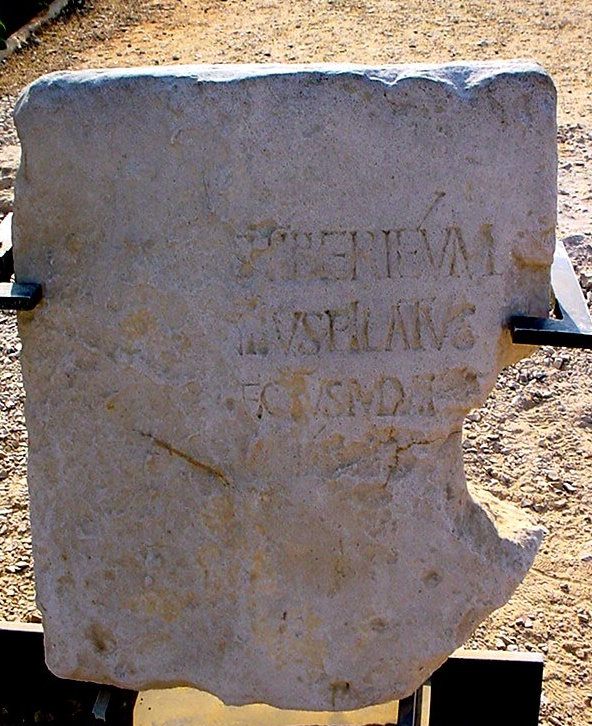
(Photo by Amir Porat – who spent an hour locating the stone after its relocation)
-
Mosaics:
Many mosaic floors were excavated in the ruins of the Roman/Byzantine city. An example of such mosaic is on display in the Ben Gurion airport. This 6th century AD mosaic floor is decorated with animals, geometric shapes, animals and trees, and in the center a woman holding a fruit basket. Her Greek name, Kalokeria, is inscribed around the figure and suggests prosperity. This is the spirit of the city: fruitful, large, plentiful, a good city.
(c) Aqueduct:
One of the famous sites in Caesarea is the Aqueduct, located to the north of the city. It is also a popular beach, accessed from the modern town of Caesarea.
A closer view of the aqueduct is seen in the next photo.
![]() For more details, visit the page of the Caesarea Aqueduct.
For more details, visit the page of the Caesarea Aqueduct.
Biblical References:
Acts (25: 11-14, 23) – Paul appeals to Caesar
In 58 AD the Apostle Paul, accused of causing a riot, was sent to Caesarea to stand trial before the governor. As a Roman citizen he requested to be heard by the Emperor , and so he sailed to Rome from Caesarea harbor. There, he was tried and executed after several years.
25:11 For if I be an offender, or have committed any thing worthy of death, I refuse not to die: but if there be none of these things whereof these accuse me, no man may deliver me unto them. I appeal unto Caesar.
25:12 Then Festus, when he had conferred with the council, answered, Hast thou appealed unto Caesar? unto Caesar shalt thou go.
25:13 And after certain days king Agrippa and Bernice came unto Caesarea to salute Festus.
25:14 And when they had been there many days, Festus declared Paul’s cause unto the king, saying, There is a certain man left in bonds by Felix:
25:15 About whom, when I was at Jerusalem, the chief priests and the elders of the Jews informed me, desiring to have judgment against him.
…
25:23 And on the morrow, when Agrippa was come, and Bernice, with great pomp, and was entered into the place of hearing, with the chief captains, and principal men of the city, at Festus’ commandment Paul was brought forth.
…
26:32 Then said Agrippa unto Festus, This man might have been set at liberty, if he had not appealed unto Caesar.
The “place of hearing”, where this all happened, is located near Herod’ palace, as seen in the following photo.
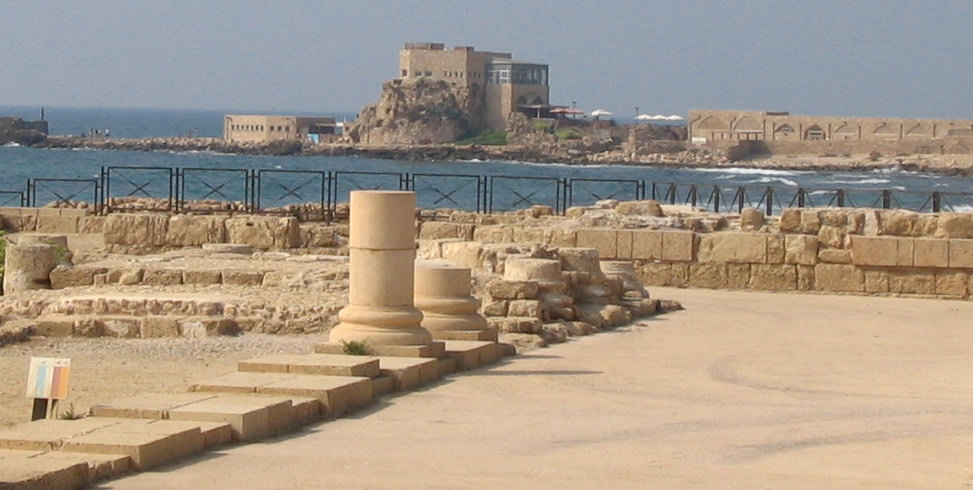
Aerial videos
![]() An aerial view of the south side of ancient Caesarea can be seen in the following Youtube video.
An aerial view of the south side of ancient Caesarea can be seen in the following Youtube video.
Another aerial view, of the Crusaders city on the north side, is seen in this next video:
Links:
For more information in BibleWalks.com:
- Caesarea Aqueduct
- Aerial views of the Holy Land sites
- The Crusaders – overview, and their sites
- BibleWalks YouTube channel (join!)
BibleWalks.com – walk with us through the sites of the Holy Land
<<<All Sites>>>—next Sharon site —> Caesarea Aqueduct
This page was last updated on Feb 15, 2023 (new overview)
Sponsored links:
